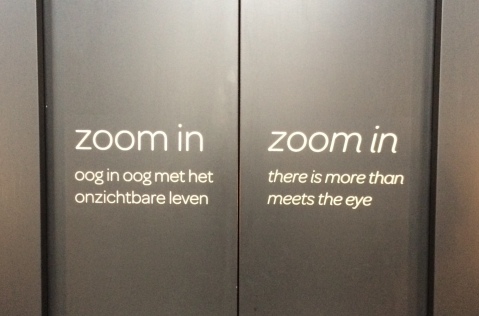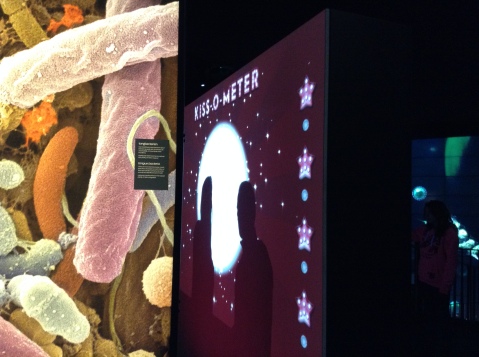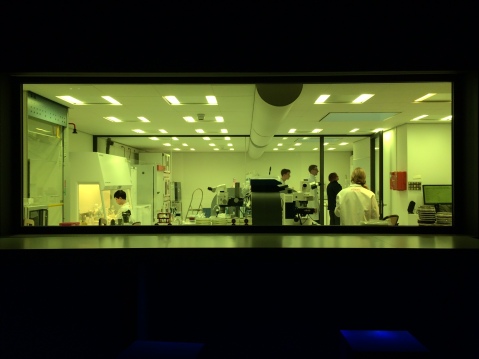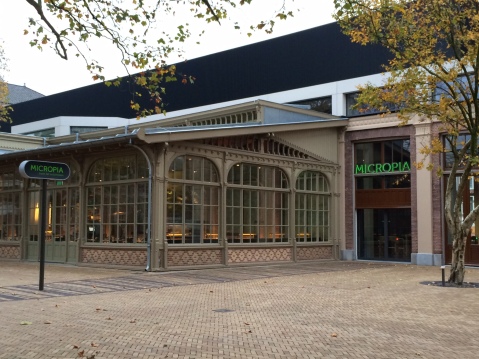Report | A first impression of Artis’ Micropia
Like light to insects, Micropia attracted our attention though their online and offline promotion (especially the captivating trams that were moving around Amsterdam like commercialized caterpillars). Unidxd visited Micropia to discover the weird and wonderful world of microorganisms.
At the Artisplein, we enter into the day lit lobby, snatching hints of what is about to come. While the windows still provide the cities’ outlines, a hostess signals towards the elevator, which takes everyone aboard to the first floor: the start of the exhibition space. But this is no ordinary ride. As the elevator cabin goes up, our gaze is lifted up towards the ceiling, where an introductory video takes us into a world undiscovered.
Apparently, the elevator functions to change the scale of the gaze, from the human view to the extreme zoom in on the micro-scale. A little disoriented, everyone gets off the elevator in a darkened space, soon after encountering brightly lit images of microorganisms. The psychedelic beauty of the exhibition could already be noticed. One more short turn leads our view along the wall, and hereafter we perceive the entire space.
Although it is not entirely clear where the exhibition ends (which is downstairs again), it seems as though we are led through a semi-structured storyline. The upper floor is an open space, where panels hold audio-visual installations. In the middle, a void allows a view of the lower floor of the building, where steps leads visitors down again (and actually, this is where we would get back to our daily, ‘human’ scale again and the knowledge of microbiology is applied to our daily lives).
Along the walls, observation stations attract the visitor’s attention with huge microscope installations, light murals, lit info screens and video touch screens. Curiosity leads us towards each station, to zoom in and discover the wonders that the naked eye cannot see. Each station provides more in depth information on what can be viewed under the microscope, for those who are not connoisseurs on the subject.
Touch screens show videos that turn out to be educational animations, which are captivating and entertaining. Some additional information can be found in other forms. However, these are often a little too abstract or encyclopaedic and without a continuing narrative for the layman to follow.
The displays and installations further along the line seem a bit more freely interpretable and ask for the visitor’s interaction (the Kiss-o-meter is a very popular one among several age groups), which makes the information relatable and transferable.
At the bottom wall of this floor there are no installations. We can see a display window that allows us to observe the laboratory on the other side. Lab workers in white coats sit behind desks, machines and microscopes and it turns out, they’re a vital part of Micropia as they cultivate new samples for the microscopes in the exhibition. Once in a while, one of the lab workers surfaces, immediately being attacked by questions from the older visitors who want to know more about what they’re doing there.

Although the girl who we happened to eavesdrop was very helpful, the distance between visitors and the lab remains obviously tangible. And confusingly, other museum staff is also dressed in lab coats, however, without the accompanying scientific knowledge to provide sufficient answers to most visitors queries.
However beautiful the remainder of the exhibition is set up, this is exactly the impression we’re left with as we move onto the stairs, down to the ground floor where we’re met by some familiar microbiological objects: a beautiful exhibition, which did not provide us with the eureka-moment where we would suddenly shed our unknowing eyes and view the world in a different way.
After leaving the Micropia space, going back to 1:1, it was clear that thousands, millions, trillions of living organisms not only co-inhabit our world: they make it survive. However, this formerly less known field still feels like the domain reserved for microbiologists, food companies and pharmaceutical industries. Of course, it might never have been the goal of the makers to involve a broader audience in the world of microbiology in such a way, but it remains questionable what the makers of the exhibition intended for the visitor to take away. Anyhow, the “Honey, I Shrunk the Kids” experience kept us entertained during our visit to Micropia.
Note: we would like to give a little extra attention to the ‘microscopical’ stencil card, which was probably used for kids, but seemed an extremely effective motivator to move around the exhibition (at astronomical speeds). Does it also function to collect knowledge?
